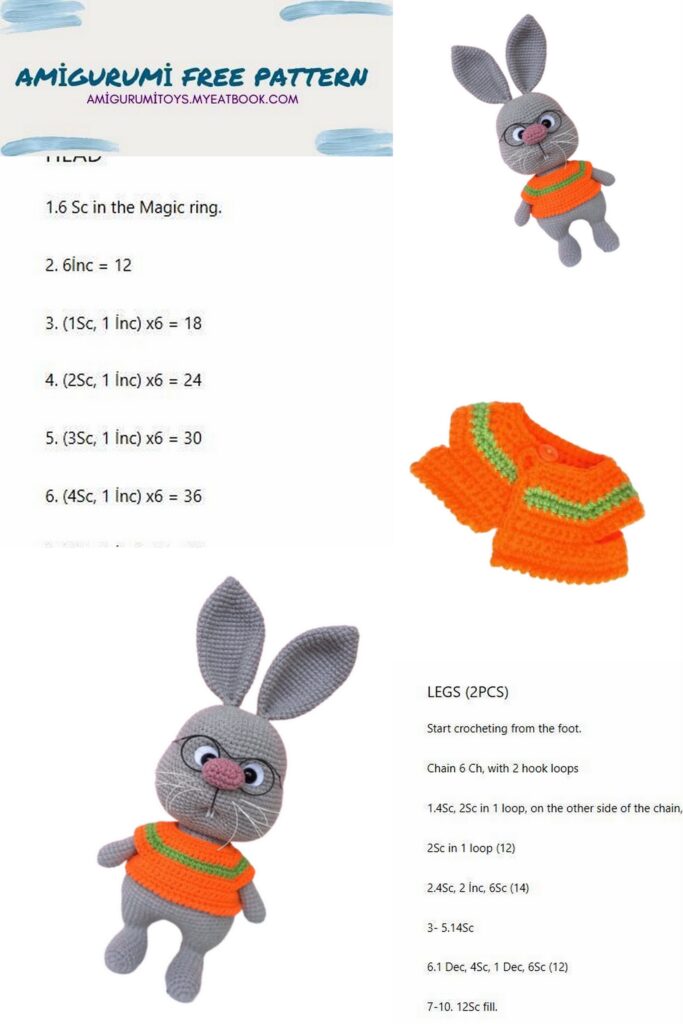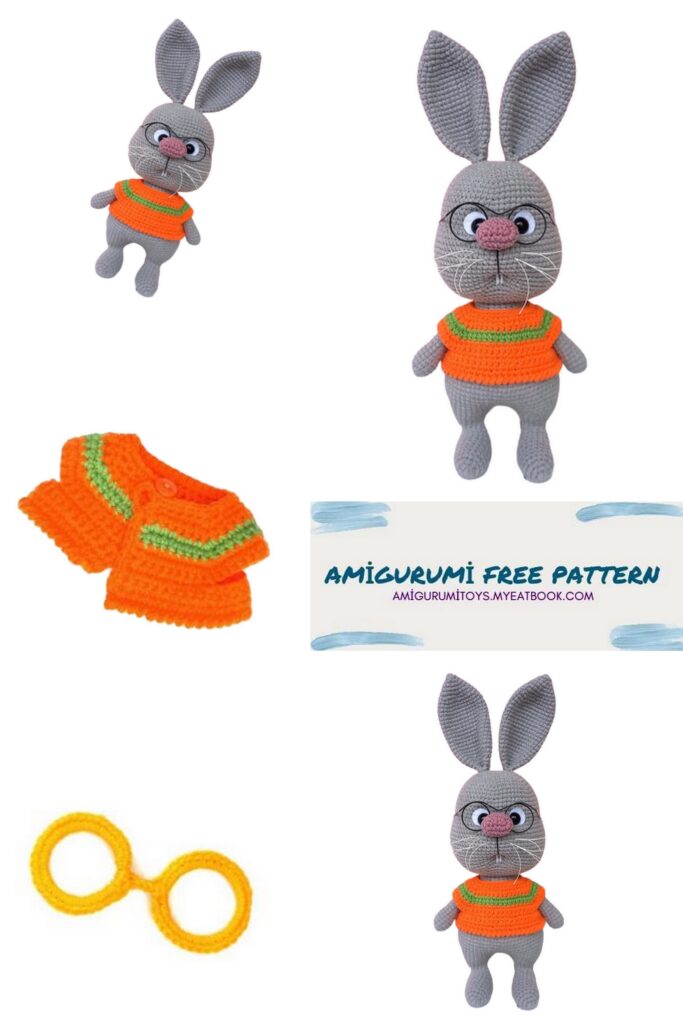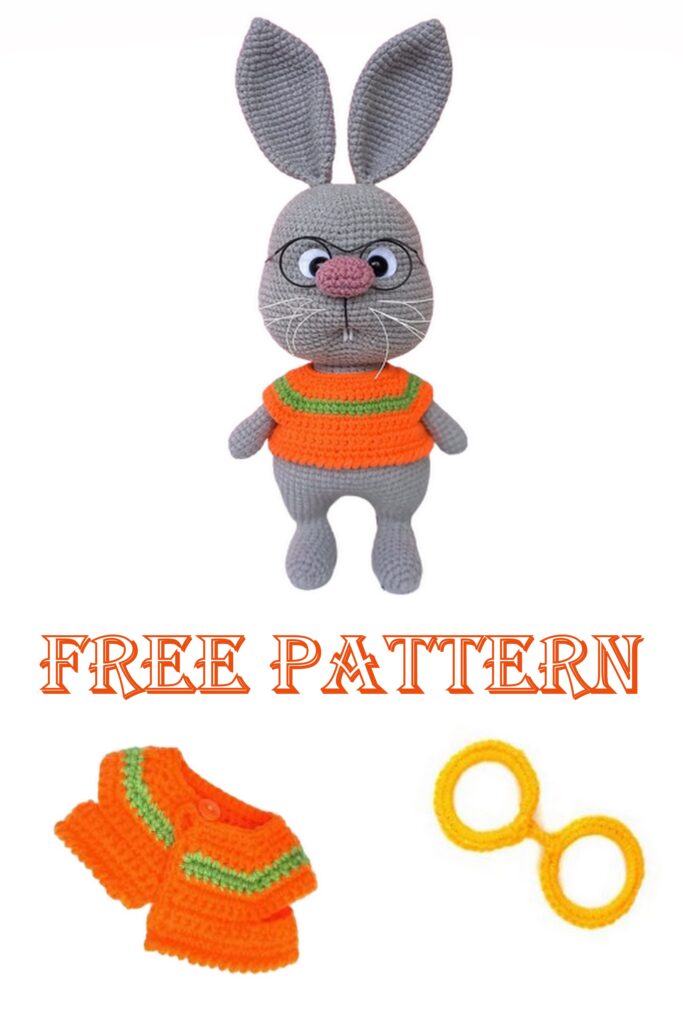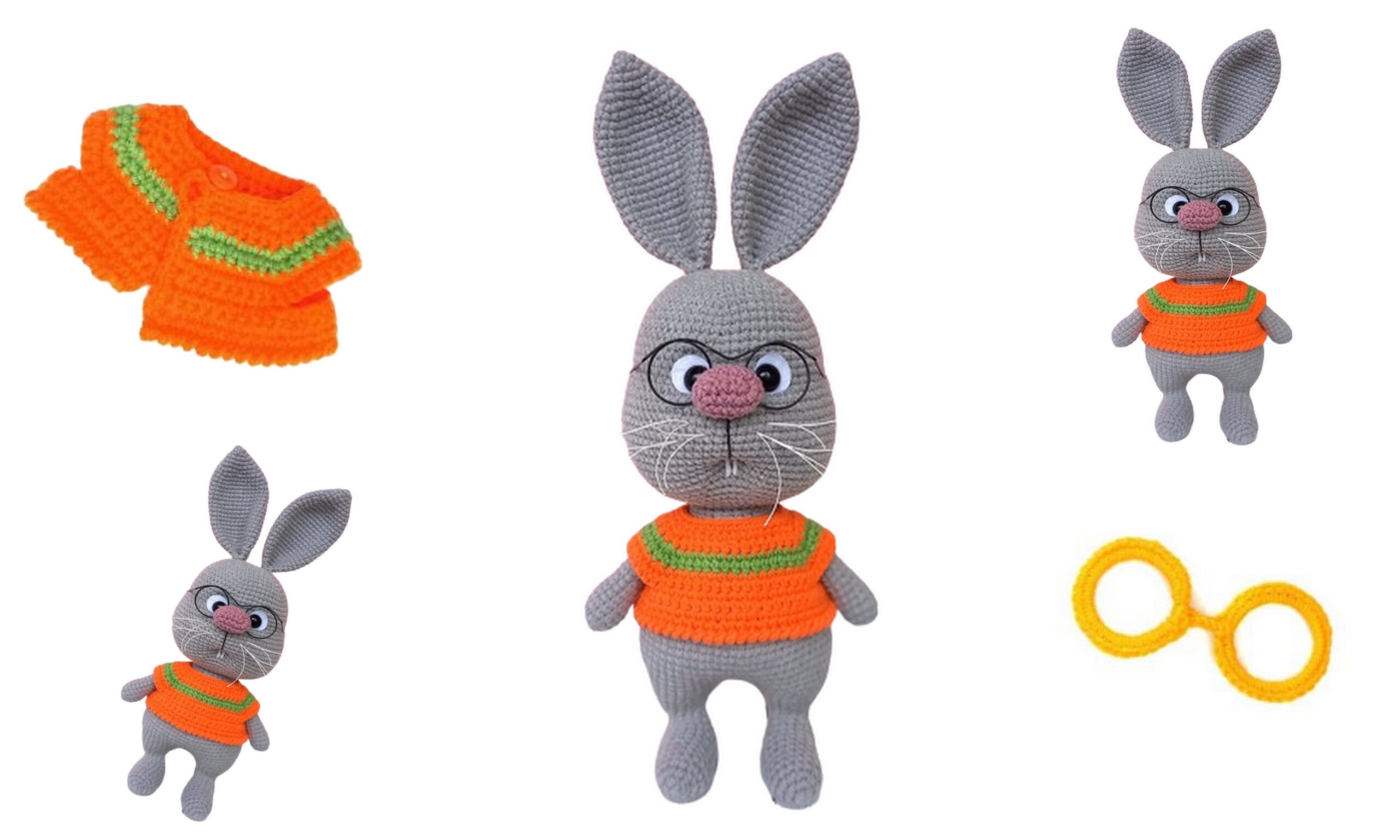The toy is knitted from the bottom up, in half-cross stitches, in a spiral, (unless otherwise indicated). The shirt is crocheted with checkmarks. The upper paws, nose and tail are tied in, the head and ears are sewn on.
When using these materials, the height of the finished toy is about 27 cm.
Mark the beginning of each row with a contrasting thread, thinner than the one you are knitting the toy with.
The description does not contain tutorials and is intended for those who already have basic crochet skills.
Required materials and tools:
1. Hook suitable for your yarn.
2. YarnArt JEANS yarn in any colors you choose. I have No. 46 main and No. 65 for the nose.
3. A little black and white thread to decorate the muzzle. Take the black one
thinner than the main one from which you will knit a toy. I used
“Openwork” from “Pekhorka” No. 02 (black 280 m / 50 gr.) Do not take for embroidery
the entire thickness of YarnArt JEANS, it will look rough on the muzzle. You can split it. But white, for teeth, take the entire thickness. I have this YarnArt JEANS No. 62. For the mustache, you can use waxed thread with a round section, 0.5 mm in diameter.
4. Filler.
5. Eyes on a secure fastening 10 mm, either sewn on or glued on (beads, half beads – your choice).
6. White felt circles with a diameter of 15 mm for proteins.
7. Needle for sewing details, scissors, pins, marker thread. Strong thread for tightening.
8. For the shirt, I used Yarnart Jeans #77 and #69
9. As an additional accessory, you can take ready-made glasses with a width of 57-60mm.


Abbreviations
MR – amigurumi ring
sc – single crochet
ch – air loop
p – loop of the previous row
inc – increase
dec – decrease
sl-st – connecting post
(…)*X – repeat X times indicated in brackets
The number after the = sign means the total number of loops in the row
Upper paws
1 row: 6 sc in MR
2 row: 6 inc = 12
3-17 rows: = 12 sc
We stuff a little only the lower part of the paws.
Fold in half and knit 6 sc for both
walls. We fasten the thread and cut it off. We will knit paws.
Nose
We dial 5 ch, from the second loop from the hook we knit:
1 row: inc, 2 sc, 4 sc in 1 loop, 2 sc, inc = 12
2nd row: 2 inc, 2 sc, 4 inc, 2 sc, 2 inc = 20
3-4 rows: 20 sc
5th row: Dec 10
Fasten the thread and cut.
You can fill the nose a little now, you can later. We will bind him.
Head
1 row: 6 sc in MR
2 row: 6 inc = 12
3 row: (1 sc, inc) * 6 = 18
4 row: (2 sc, inc) * 6 = 24
5 row: (3 sc, inc) * 6 = 30
6 row: (4 sc, inc) * 6 = 36
7 row: (5 sc, inc) * 6 = 42
8 row: (6 sc, inc) * 6 = 48
9 row: (7 sc, inc) * 6 = 54
10 row: (8 sc, inc) * 6 = 60
11-12 rows: 60 sc
13 row: (9 sc, inc) * 6 = 66
14-18 rows: 66 sc
In the next row, we will tie out the cheeks and tie in the nose.
19 row: 19 sc, (1 sc, inc) * 6, 5 sc with 5 nose loops, (inc, 1 sc) * 6, 18 sc = 78
20 row: 37 sc, 5 sc on the remaining loops of the nose, 36 sc = 78
We stuff the spout a little, if we haven’t stuffed it before.
21-30 rows: 78 sc
If you are using eyes on a secure mount, then install them at this stage.
Between 17 and 18 rows. Between installation sites 6-8 sc. Center the eyes on the nose.
We take circles from felt. Carefully, so that there is no wrinkling, fold in half and make small cuts, shifting slightly from the center to the edge.
We turn the circles and make perpendicular cuts (as a result, we get a crosswise pattern). We insert eyes into them and fix them in the canvas.
Later, after tightening, the felt can be carefully fixed with glue.
31 row: (11 sc, dec) * 6 = 72
32 row: (7 sc, dec) * 8 = 64
33 row: (6 sc, dec) * 8 = 56
34 row: (5 sc, dec) * 8 = 48
35 row: (4 sc, dec) * 8 = 40
36 row: (3 sc, dec) * 8 = 32
37 row: (2 sc, dec) * 8 = 24
We stuff the head tightly, but without too much zeal
Keep in mind that there will be stretch marks. We fix the thread and hide it inside.


Ears
These details are not stuffed
1 row: 6 sc in MR
2 row: (1 sc, inc) * 3 = 9
3 row: (2 sc, inc) * 3 = 12
4 row: (3 sc, inc) * 3 = 15
5 row: (4 sc, inc) * 3 = 18
6 row: (2 sc, inc) * 6 = 24
7 row: 24 sc
8 row: (3 sc, inc) * 6 = 30
9-23 rows: 30 sc
24 row: (3 sc, dec) * 6 = 24
25 row: 24 sc
26 row: (2 sc, dec) * 6 = 18
27 row: 18 sc
Fold the eyelet in half and tie together behind both walls 9 sc. Leave the thread for sewing.
Tail
1 row: 6 sc in MR
2 row: 6 inc = 12
3 row: (1 sc, inc) * 6 = 18
4-5 rows: 18 sc
6 row: (1 sc, dec) * 6 = 12
We fasten the thread and cut it off. We will tie the tail. You can lightly fill it now, you can after knitting.
Lower legs
1 row: 6 sc in MR
2 row: 6 inc = 12
3 row: (1 sc, inc) * 6 = 18
4-9 rows: 18 sc
next we will knit the heel
10 row: 1 ch, turn, 1 sc skip, 9 sc, dec
11 row: 1 ch, turn, 1 sc skip, 7 sc, dec
12 row: 1 ch, turn, 1 sc skip, 5 sc, dec
13 row: 1 ch, turn, 1 sc skip, 3 sc, dec
knit to the marker, along the edge loops 4 more sc
14 row: continue knit 18 sc, including edge loops of the heel = 18
15 row: 18 sc
16 row: (1 sc, dec) * 6 = 12
17-18 rows: 12 sc
19 row: (1 sc, inc) * 6 = 18
20 row: 18 sc
21 row: (2 sc, inc) * 6 = 24
22 row: 24 sc
We fix the thread on the first leg and cut it off. On the second we do not cut, we connect it with the first and continue knitting.
We remove the marker threads and put the legs side by side. We determine the junction so that it is symmetrical. If your degree of displacement coincides with mine, then on the first leg we count back 11 loops and in the 12th we will connect with the second.


Body
We stuff tightly, in the process of knitting.
We knit a chain of 3 ch, connect the paws.
1 row: 24 sc in the first leg, 3 sc in a chain of ch, 24 sc in the second leg, 3 sc in a chain of ch.
The total number of loops in a row = 54
We put a marker thread.
2 row: (8 sc, inc) * 6 = 60
3 row: 60 sc
4 row: (9 sc, inc) * 6 = 66
5-7 rows: 66 sc
in the 8th and 9th rows we knit a tail.
8 row: 61 sc, then 6 sc with
ponytail, capturing 1 loop of the next row = 66
We put the marker in the 9th row after 66 loops, the loop count does not change.
Please note that your knitting offset may vary. Position the ponytail in the back center.
9 row: = 61 sc, 6 sc in the remaining loops of the tail, also, capturing 1 loop of the next row = 66
For convenience, the marker thread can be pulled out and installed again, before the first loop of the 10th row (after the 5th loop in the tail).
After the 10th row, I fill the feet and ponytail.
10-11 rows: 66 sc
12 row: (9 sc, dec) * 6 = 60
13 row: 60 sc
14 row: (8 sc, dec) * 6 = 54
15 row: 54 sc
16 row: (7 sc, dec) * 6 = 48
17 row: 48 sc
18 row: (6 sc, dec) * 6 = 42
19 row: 42 sc
20 row: (5 sc, dec) * 6 = 36
21-23 row: 36 sc
In the 24th row we will knit the upper paws. Stuff the main part
the calf is quite tight, but not completely. Leave about 1 cm so that when knitting the paws you are comfortable and the filler does not fall between the posts. We determine the knitting points strictly on the sides: 6 sc along with the paws, 12 sc between them.
Given my offset, I ended up with this:
24 row: 8 sc, 6 sc with the foot, 12 sc, 6 sc with the foot, 4 sc = 36
25 row: 36 sc
26 row: (4 sc, dec) * 6 = 30
27 row: (3 sc, dec) * 6 = 24
28 row: 24 sc
We knit a few more columns (I got 1 sc and sl-st in the next loop), fasten the thread at the back in the center of the back.
We leave about 50 cm for sewing on the head. Remove the marker thread. tight
we fill the part to the end. When sewing on the head, do not forget to knock the filler into the neck. For convenience, you can fix the head with the body with a knitting needle.
We will form the mouth and eye sockets with a tightening. Mark with pins on the muzzle 6 points.
Define the middle of the muzzle. This can be done conveniently by placing a thread, needle or needle down from the center of the nose. We put marks between 29 and 30 rows. Between pins 2-3 sc.
Between the 18th and 19th rows, we mark 4 more points from the outer and inner corners of the eyes. From the inner corners, this is the beginning and end of the knitted spout. Between internal and external points 2-3 sc.
We insert the needle at point 1, leave the end of the thread about 25-30 cm, we bring it out at point 2. Then we go to point 3, we bring it out at point 6.
We correct the thread so that it is under the eye and a felt circle, tighten it, tie it into 2 knots. Without cutting the thread, we enter at point 6, bring it out at point 5, then to point 4, we bring it out at point 1. We tighten it, we tie it into a couple of knots. hide the threads inside the head. The last knot and the entry and exit points of the threads can be carefully smeared with universal transparent glue. I have Moment Crystal.
Sew on the ears
Fold the ear in half and sew both sides together.
Then sew to the head to your liking. I sewed between rows 3 and 4
With a thin black thread we embroider a strip from the nose to the mouth. Embroider teeth with white thread.
Optionally, you can add eyebrows, “folds”
over the cheeks.
crochet shirt
We knit in rotary rows with a lifting loop. Colors can be combined, using melange yarn or sectional dyeing yarn, textured, woolen. The main thing is that it fits in thickness.
We collect 37 ch, in the opposite direction, from the 2nd loop from the hook:
1st row: 6 sc, 3 sc in 1 st, 4 sc, 3 sc in 1 st, 12 sc, 3 sc in 1 st, 4 sc, 3 sc in 1 st, 6 sc = 44; ch, turn
2 row: 44 sc, ch, turn
3rd row: 7 sc, 3 sc in 1 st, 6 sc, 3 sc in 1 st, 14 sc, 3 sc in 1 st, 6 sc, 3 sc in 1 st, 7 sc = 52; ch, turn
4 row: 52 sc, ch, turn
5 row: 8 sc, 3 sc in 1 st, 8 sc, 3 sc in 1 st, 16 sc, 3 sc in 1 st, 8 sc, 3 sc in 1 st, 8 sc, = 60; ch, turn
6 row: 60 sc ch, turn
7 row: 9 sc, a chain of 6 ch, 12 sc skip, 18 sc, a chain of 6 ch, 12 sc skip, 9 sc, = 48; ch, turn
8 row: 8 sc, inc, 6 sc in air loops, inc, 16 sc, inc, 6 sc in air loops, inc, 8 sc = 52; ch, turn
9 row: 52 sc ch, turn
We do not break the thread, we make a strapping (in corner loops of 3 sc):
along the edge up, the neck, along the edge down (do not forget about the loop 4-5 ch, depending on the diameter of your button) and the bottom with a false “crustacean step”.
Or the bottom as well, we tie it with single crochets and in we return to the usual “crustacean step.”
We fix the thread, hide all the tips and cut. The shirt is ready.


Glasses
I used ready made ones. In the region of the bridge of the nose, she slightly parted them, slightly unbent.
Due to the arms rounded at the ends, they are quite firmly attached to the canvas.
Glasses can be made independently using wire, wire cutters and any object that is suitable in diameter. You can tie them, or you can take a braided wire. The photo shows white, but it comes in different colors.
Glasses without temples can be secured to the bridge of the nose with a couple of stitches. Thanks to the upturned nose, it will be imperceptible.
Here is our bunny!
